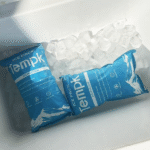Shipping temperature-sensitive products, like frozen foods, pharmaceuticals, and biological samples, requires reliable cooling solutions. Dry ice shipping bags provide an effective way to keep goods cold throughout transit. This guide covers how to use dry ice shipping bags safely, best practices, and the benefits for businesses involved in cold chain logistics.
-
What are dry ice shipping bags, and how do they work?
-
How can you properly pack dry ice for shipping?
-
What are the best practices for using dry ice bags for deliveries?
-
How can businesses benefit from dry ice shipping bags?
What Are Dry Ice Shipping Bags and How Do They Work?
Dry ice shipping bags are durable containers designed to transport dry ice safely, ensuring that products remain frozen during transit. These bags are typically made from materials like polyethylene and kraft paper, offering insulation and preventing premature sublimation of the dry ice.
-
Key Benefits of Dry Ice:
-
Sublimates at -78.5°C (-109.3°F), providing excellent cooling for perishable goods.
-
No water residue—dry ice sublimates into gas, unlike regular ice that leaves moisture behind.
-
Effective for longer shipments, maintaining the low temperature without compromise.
-
Why Use Dry Ice Shipping Bags for Deliveries?
Using dry ice bags provides an efficient and secure method for transporting temperature-sensitive goods:
-
Efficient Cooling: Dry ice offers a longer cooling period than traditional ice, making it ideal for long-distance shipments.
-
No Water Residue: Dry ice sublimates into gas, preventing moisture damage to goods.
-
Regulated Temperature: Ensures consistent cooling, crucial for sensitive products like food and pharmaceuticals.
Best Practices for Using Dry Ice Shipping Bags
To ensure safe and efficient shipping, follow these best practices:
-
Choose the Right Bag: Select a dry ice bag with adequate insulation to slow sublimation. Multi-layer bags are ideal for longer transit durations.
-
Pre-cool Your Shipping Container: Pre-cool the shipping container to maintain a stable temperature.
-
Pack Efficiently: Place dry ice at the bottom and the products on top. Cold air from sublimation will flow over the items, ensuring proper cooling.
How to Properly Pack Dry Ice for Shipping
-
Use the Correct Amount: For 24-hour shipments, use 5-10 lbs of dry ice per 10 lbs of perishable goods.
-
Ensure Ventilation: Proper ventilation prevents dangerous CO₂ build-up, which can happen when dry ice sublimates in an airtight container.
-
Seal the Bag Securely: Make sure the dry ice bag is tightly sealed to reduce gas loss during transit.
| Packaging Type | Insulation Type | Best Use | Duration |
|---|---|---|---|
| Dry Ice Shipping Bag | Multi-layered plastic | Short-distance | 12-24 hours |
| Thermal Insulated Bag | Foam or vacuum-sealed | Long-distance | 24-72 hours |
| Polyethylene Shipping Bag | Durable plastic | Direct contact | 12-48 hours |
Common Mistakes to Avoid When Shipping with Dry Ice
-
Incorrect Labeling: Always mark the package with “Dry Ice” and the net weight of the dry ice.
-
Too Much Dry Ice: Overpacking leads to excessive sublimation, potentially compromising the product.
-
Failure to Check Regulations: Adhere to specific carrier regulations, including the 5.5 lbs per package limit without special arrangements.
How to Maximize the Benefits of Dry Ice Shipping Bags
Enhance Product Quality
By using dry ice, you ensure that perishable products remain at the required temperature, reducing spoilage risks. Whether shipping frozen foods, biologics, or pharmaceuticals, dry ice guarantees product integrity.
Expand Service Offerings
Dry ice bags enable businesses to offer reliable cold chain logistics, providing the capacity to ship a wide range of temperature-sensitive products.
Improve Customer Satisfaction
Today’s consumers demand high-quality products delivered in perfect condition. By using dry ice shipping bags, businesses can enhance customer loyalty by guaranteeing that their goods remain cold.
Protect the Environment
As sustainability becomes more critical, eco-friendly dry ice shipping bags made from recyclable materials offer a more sustainable alternative to traditional packaging.
2025 Trends in Dry Ice Shipping Bags
Recent innovations in dry ice shipping bags are making cold chain logistics more efficient and sustainable:
-
Smart Packaging: Temperature sensors integrated into dry ice bags provide real-time monitoring of shipping conditions.
-
Sustainable Materials: Manufacturers are developing biodegradable dry ice bags, reducing environmental impact.
-
Improved Sublimation Control: Advances in insulation materials help regulate the sublimation rate, increasing efficiency.
Market Insights
The growing e-commerce and pharmaceutical markets are driving demand for dry ice shipping bags, particularly in the food, pharma, and biotech industries, which require precise temperature control during transit.
Frequently Asked Questions
Q1: How much dry ice should I use in my shipment?
For a 24-hour shipment, use 5-10 lbs of dry ice per 10 lbs of perishable goods. For longer shipments, adjust according to the duration and insulation quality.
Q2: Can I reuse dry ice shipping bags?
Yes, dry ice bags can be reused if made from durable materials. Be sure to inspect and clean them thoroughly before reuse.
Q3: What is the maximum dry ice weight per package?
Air transport regulations limit dry ice to 200 kg per package. For consumer shipments, typical shipments use 5-10 lbs per 24 hours.
Summary and Recommendations
Using dry ice shipping bags is essential for businesses looking to maintain product quality and ensure customer satisfaction in cold chain logistics. Follow proper packing and best practices to guarantee safe delivery.
Action Plan
-
Evaluate Your Needs: Determine if dry ice is the right solution for your cold chain needs.
-
Implement Best Practices: Review your packaging, shipping, and labeling processes to ensure they comply with industry standards.
-
Stay Updated on Trends: Monitor the latest advancements in cold chain logistics to optimize your shipping processes.
About Tempk
Tempk offers specialized cold chain solutions for shipping temperature-sensitive goods. With a focus on sustainability, innovation, and reliability, our services ensure safe and efficient delivery of perishable products.
Contact us today for expert advice on optimizing your dry ice shipping processes.
























